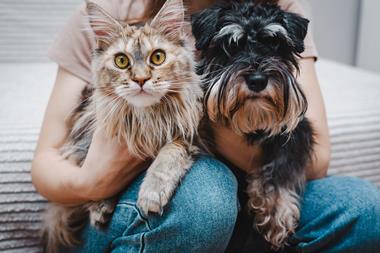While the UK pet insurance market has grown rapidly in recent years, its ability to detect and combat fraud has not caught up – with the size of this problem not yet known
The UK pet insurance sector has grown rapidly in recent years, with further growth forecast for the business line.

But as the size of the sector has increased, its ability to protect against and combat insurance fraud has not caught up with other more established lines of business.
According to GlobalData’s UK Pet Insurance Market Overview report, published on 4 October 2023, this market was valued at £1.58bn in 2022 and is expected to achieve an impressive compound annual growth rate of more than 4% between 2022 and 2027.
Supporting this view, ABI statistics from last year (21 June 2023) revealed that insurers paid out over £1bn across 1.3 million pet insurance claims in 2022 – with this figure rising 17% year-on-year.
Market growth was spurred by increased demand as a result of the Covid-19 pandemic, when pet ownership levels across the country rose significantly.
During the pandemic in 2020, ManyPets’ former chief executive, Steven Mendel, told Insurance Times that the firm had recorded a 194% year-on-year increase in new pet insurance policies.
Despite this large increase in the volume of pets and the associated policyholders that pet insurers must now service, the line remains underdeveloped in terms of both policy validation and fraud identification technology – relative to more data rich lines such as motor or home.
Speaking exclusively to Insurance Times, Shift Technology customer success manager Laura Horrocks explained: ”Pet insurance, like travel, is an easy target [for fraudsters] in the industry – and until someone is the first to take a hard line approach to dealing with it, it will continue.”
Sam Lee, fraud risk and technical manager at Markerstudy, agreed that pet insurance was “an emerging threat” that was “coming to light more and more” in the counter fraud sector.
What the cat dragged in
In conversations with Insurance Times, counter fraud experts explained that fraud in pet insurance was originating from two main sources and taking a number of forms.
Read: Industry must move on from identifying fraud via ‘particular profiles’ of fraudster
Read: Pet premiums drop as CMA announces vets market concerns
Explore more fraud-related content here or discover other news analysis stories here
Most prominently, a primarily digital journey at application means that opportunistic policyholders motivated by the desire to reduce their premiums can misrepresent aspects of their pets’ health by, for example, not disclosing pre-existing medical conditions or the exact breed of their dogs.
Lee explained: ”The premiums for different breeds of dog are dramatically different, so a french bulldog would have a higher cost to insure than a crossbreed. Some customers might try to manipulate their quotes around this.”
Another form of fraud Lee’s team had identified was that fraudulent policyholders would claim for the death of an animal and receive a payout, before then trying to incept another policy for the same animal with a different insurer.
He continued: ”Pre-inception fraud is another thing we see a lot, especially with cats, where customers will have their pet go missing and then a week later, following a waiting period, take out the policy and claim for a missing pet.”
As well as originating from individual policyholders, pet insurance fraud is particularly challenging to deal with when it originates from veterinarians themselves because of the highly specialised medical knowledge they possess.
Horrocks said: ”It’s not all vets that are doing this obviously, but the opportunity for them to commit fraud is there because of the automatic validation – they’re the experts, so a lot of the process is handed over to the vet and trust is placed in them around what procedures are needed and what price is being paid.”
Fraudulent activity originating from treatment providers can take the form of kickbacks, or simply exaggerating the costs of treatment to receive more money from a claim payout.
Were a fraudulent veterinarian so inclined, for example, they could collude with a customer to take advantage of an insurance policy by falsely submitting records of completed tests and operations, have the policyholder claim for the cost and then share some of the ill-gotten gains with the customer as a kickback or discount on further treatment.
Or, as in one case reported by the ABI in May 2023, an employee at a veterinary practice was caught fraudulently claiming over £37,000 from six different insurers for pets that she had made up the names and breeds of. She achieved this by altering invoices for medical treatment her practice had sent to genuine customers.
Horrocks added: “It’s an area that the average individual knows very little about. Any provider that did want to add additional costs could do so very easily without the knowledge of the insured.”
Old dog, new tricks
Despite the unique challenges for counter fraud professionals working in pet insurance, there are potential solutions.
For example, the collection of more data and use of data analytics can allow counter fraud professionals to identify suspicious activity better than manual handlers, while also providing insights into trends associated with unusual spikes in activity.
Horrocks said: ”Data analytics would allow pet providers to identify, for example, a provider that tends to add £300 onto each invoice compared to what we would usually see for that type of treatment – but even that would be quite difficult because you may not see that type of claim with that type of injury or particular operation all too often.
“However, without that data analysis, it’s difficult to build up a big picture where you can see the patterns and that’s why looking at average settlement costs for a particular type of event and identifying outliers is of particular interest to us.”
Outside of the need to modernise and improve the sector’s data capabilities as it continues to grow, which Lee agreed was vital, he explained that various efforts at increased validation and monitoring of suspicious activity would also help.
He said: ”Pet’s different to other books because there’s a different level of expertise required to spot that there’s something wrong, so we do have qualified and part-qualified vet nurses working for us that can really help with the identification of what’s wrong.
“We do have fairly solid validation in place, but it’s very manual and finding room for more data led solutions is probably the future here.”
Lee also referenced situations outside of the insurance and counter fraud sectors’ control that would help protect against fraudulent insurance claims. For example, he noted that cat microchipping, which all owners are legally required to complete by 10 June 2024, would help to enable fraud detection.
New methods of tackling the growing issue of fraud in pet insurance are only in the development stages however, as the size of the problem itself is not entirely known.
But, as anyone in the counter fraud sector acknowledges, both professional and opportunistic fraudsters are all too happy to exploit blind spots in insurers’ defences – and the growing pet market is one target that must ensure it does everything possible to head off these challenges.

With a particular interest in regulation, technology, innovation and political stories, he has covered issues from the multioccupancy buildings scandal to the insurance implications of quantum computing and the growth of new markets.View full Profile
Hosted by comedian and actor Tom Allen, 34 Gold, 23 Silver and 22 Bronze awards were handed out across an amazing 34 categories recognising brilliance and innovation right across the breadth of UK general insurance.























































No comments yet